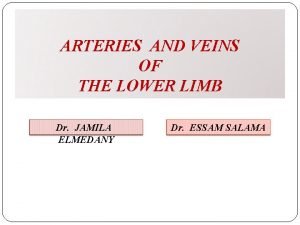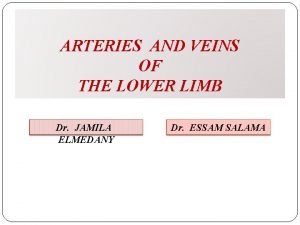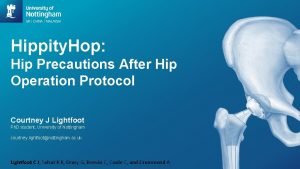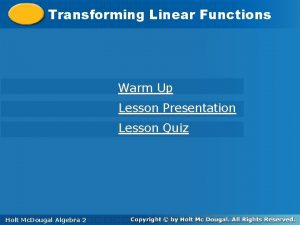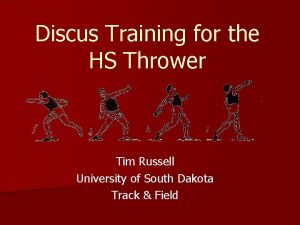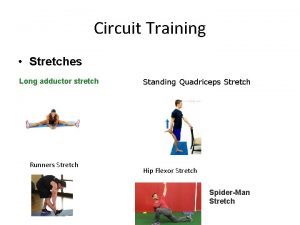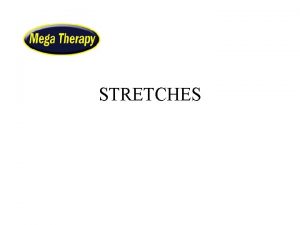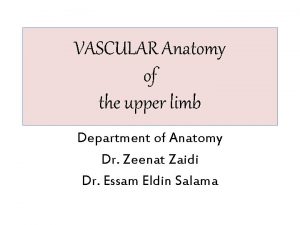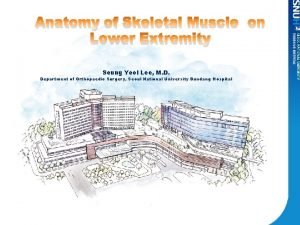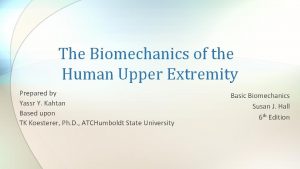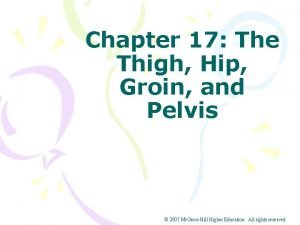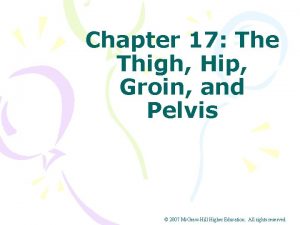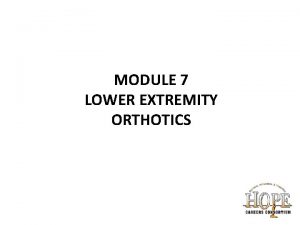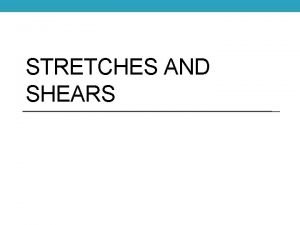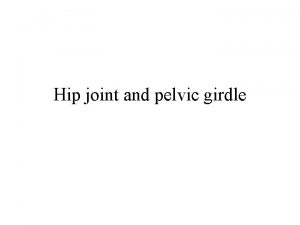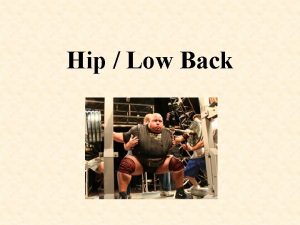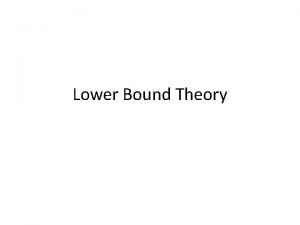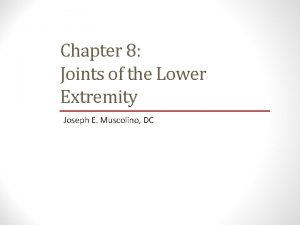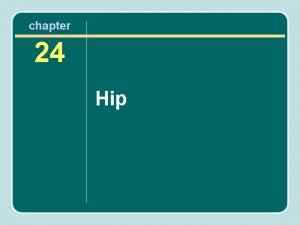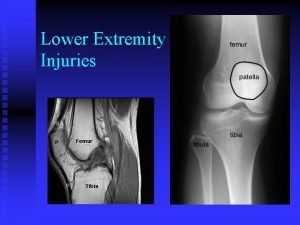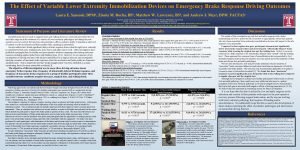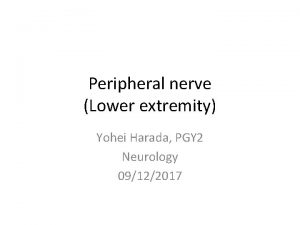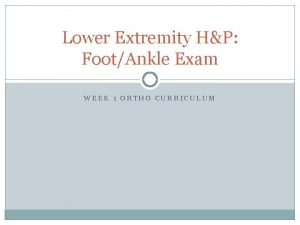Stretches for the Lower Extremity Chapter 4 Hip




































- Slides: 36

Stretches for the Lower Extremity Chapter 4

Hip Extensors: Hamstrings and Gluteus Maximus • Anatomy: Chronically shortened hamstrings can contribute to these conditions: • • • Low back pain Knee pain Leg length differences Restricted stride length Overworked quadriceps • Gluteus maximus is a powerful hip extensor that can be involved in low back pain.

Hamstrings and Gluteus Maximus: Review Origins, Insertions, and Actions Adapted, by permission, from R. S. Behnke, 2005, Kinetic anatomy, 2 nd ed. (Champaign, IL: Human Kinetics), 180.

Functional Assessment: Hip Flexion to 90 Degrees With the Knee Straight Is Ideal

Hip Rotators: Piriformis • One of six deep lateral hip rotators, all of which insert on some portion of the greater trochanter. • When these muscles are hypertonic, they contribute to a toe-out gait seen in dancers, and they restrict internal rotation of the hip. Stretching the piriformis also stretches the other lateral rotators. • Although the piriformis is considered a lateral rotator of the hip, it may be more of a postural muscle, stabilizing the spine and maintaining pelvic balance in conjunction with the psoas (Myers 1998).

Piriformis: Review Origin, Insertion, and Action

Functional Assessment (Piriformis): The Path of the Sciatic Nerve Through the Lateral Rotators

Hip Abductors • Primary abductors of the hip are the tensor fasciae latae (TFL) and the gluteus medius and minimus. • These muscles abduct the hip and also stabilize it during weight-bearing activities. • Tightness in these muscles can contribute to pelvic imbalances, which can cause pain in the hips, low back, and knees.

Hip Abductors: Review Origins, Insertions, and Actions

Hip Abductors: Functional Assessment Abductor tightness test (modified Ober’s test). Excessive tightness in the hip abductors prevents this position. Typical pain sites for iliotibial band syndrome. Fig. 4. 14 (right): Adapted, by permission, from R. S. Behnke, 2005, Kinetic anatomy, 2 nd ed. (Champaign, IL: Human Kinetics), 202.

Anatomy: Hip Adductors • When you bring your legs together (toward your midline), you use adductor muscles. • Adductor muscles can be divided into the short adductors (pectineus, adductor brevis, and adductor longus) and the long adductors (adductor magnus and gracilis). • We’ve provided one illustration showing all the adductors.

Hip Adductors: Review Origins, Insertions, and Actions Adapted, by permission, from R. S. Behnke, 2005, Kinetic anatomy, 2 nd ed. (Champaign, IL: Human Kinetics), 183.

Hip Adductors: Functional Assessment 50° Normal range of hip abduction is 45 to 50 degrees from the midline. Limited range is usually due to tight adductors.

Hip Flexors: Quadriceps Group • Quadriceps consist of four muscles and are powerful extensors of the knee. • One of the quads, the rectus femoris, also crosses the hip joint and acts as a hip flexor, assisting the psoas. • Chronically short quads can contribute to low back pain. The quadriceps are usually involved in any type of knee pain or instability.

Quadriceps Group: Review Origins, Insertions, and Actions Adapted, by permission, from R. S. Behnke, 2005, Kinetic anatomy, 2 nd ed. (Champaign, IL: Human Kinetics), 198.

Quadriceps: Functional Assessment Normal range of knee extension. (a) The quadriceps should fully extend the knee. (b) The arc of motion should be smooth, with no hesitation or jerkiness.

Hip Flexors: Psoas and Iliacus • Iliopsoas is the primary hip flexor. • Because of its attachment along the lumbar spine, it affects the angle of the lumbar curve. A psoas that is too tight can cause an increase in the curve, which leads to swayback and low back pain. • However, sometimes a tight psoas will flatten the lumbar curve, which can also lead to low back pain. For a more detailed discussion of this seeming contradiction, see Tom Myers’ article “Poise: Psoas-Piriformis Balance” (1998).

Psoas and Iliacus: Review Origins, Insertions, and Actions Adapted, by permission, from R. S. Behnke, 2005, Kinetic anatomy, 2 nd ed. (Champaign, IL: Human Kinetics), 178.

Psoas and Iliacus: Functional Assessment 120° a b 30° Normal range of (a) hip flexion and (b) hip extension.

Plantarflexors: Gastrocnemius and Soleus • Gastrocnemius-soleus muscles are also called the triceps surae. • They insert into the heel via the Achilles tendon, the strongest tendon in the body. The gastrocnemius is a two-headed muscle that gives the calf its shape. • The soleus muscle, which lies underneath the gastrocnemius, is more often the reason for calf tightness.

Gastrocnemius and Soleus: Review Origin, Insertion, and Action Adapted, by permission, from R. S. Behnke, 2005, Kinetic anatomy, 2 nd ed. (Champaign, IL: Human Kinetics), 202.

Gastrocnemius and Soleus: Functional Assessment 20° a b (a) Normal range of dorsiflexion at the ankle. (b) With the knee bent, the gastrocnemius is slack, and any limitation in dorsiflexion is probably due to a tight soleus.

Gastrocnemius and Soleus: Functional Assessment (continued) 50° Normal range of ankle plantarflexion is 50 degrees.

Toe Flexors: Flexor Hallucis Longus, Flexor Digitorum Longus • We discuss only two of the six toe flexors (flexor hallucis and flexor digitorum longus). The muscle table lists all six toe flexors. • With the foot on the ground, flexor hallucis and digitorum longus assist in maintaining balance by keeping the toe pads on the ground. • Flexor hallucis longus helps support longitudinal arch and exerts a strong propulsion action during toe-off phase of gait.

Flexor Hallucis Longus and Flexor Digitorum Longus: Review Origins, Insertions, and Actions

Flexor Hallucis Longus and Flexor Digitorum Longus: Functional Assessment Normal range of motion of the great toe: 80 degrees of extension, 25 degrees of flexion.

Dorsiflexors: Tibialis Anterior • When the foot is free to move, tibialis anterior dorsiflexes and inverts it. • When the foot is on the ground, tibialis anterior assists in maintaining balance. • During walking or running, it helps prevent the foot from slapping onto the ground after heel strike and lifts the foot to clear the ground as the leg is swinging forward.

Tibialis Anterior: Review Origin, Insertion, and Action Adapted, by permission, from R. S. Behnke, 2005, Kinetic anatomy, 2 nd ed. (Champaign, IL: Human Kinetics), 216.

Tibialis Anterior: Functional Assessment

Toe Extensors: Extensor Hallucis Longus, Extensor Digitorum Longus • We illustrate and discuss only two of the four toe extensors (extensor hallucis longus and extensor digitorum longus). The muscle table lists all four toe extensors. • Extensor hallucis longus and extensor digitorum longus help control the speed of descent of the forefoot to the ground following heel strike, preventing the foot from slapping onto the ground. • They also contribute to postural stability by controlling posterior sway. • With the foot anchored to the ground, they pull the leg forward at the ankle.

Extensor Hallucis Longus and Extensor Digitorum Longus: Review Origins, Insertions, and Actions

Extensor Hallucis Longus and Extensor Digitorum Longus: Functional Assessment Normal range of motion of the great toe: 80 degrees of extension, 25 degrees of flexion.

Evertors: Peroneal (Fibularis) Group Invertors: Tibialis Anterior and Posterior • Eversion (pronation) and inversion (supination) of the foot occur with every step. • Proper function of evertors and invertors is critical for biomechanics and stability. • Invertors and evertors often control movement rather than initiate it. • Primary evertors are two of the three peroneal muscles (also known as fibularis muscles): peroneus longus and peroneus brevis. They make up the lateral compartment of the leg. The peroneus tertius is in the anterior compartment with the tibialis anterior. • Although peroneals are most often considered evertors, they also stabilize the foot, ankle, and leg. • Primary invertors are tibialis anterior and posterior. The tibialis posterior is the deepest muscle in the calf.

Evertors and Invertors: Review Origins, Insertions and Actions Adapted, by permission, from R. S. Behnke, 2005, Kinetic anatomy, 2 nd ed. (Champaign, IL: Human Kinetics), 216, 217.

Evertors and Invertors: Functional Assessment Normal ROM for inversion (supination) is 45 degrees; for eversion (pronation) it is 20 degrees.

Spiral–Diagonal Patterns for the Lower Extremity • Not all spiral patterns for the leg lend themselves to stretching. Extension end of the D 2 pattern is awkward. • Compared to single-plane stretches, the patterns require more concentration from both the stretcher and you. • Illustrate what you want the stretcher to do by taking him through the pattern passively. • You’re trying to improve ROM at the end of the pattern. Start with the stretcher at the end of his range in all three planes of motion. In isometric phase, stretcher attempts to move toward the opposite three planes (toward the shortened direction). • After isometric effort, stretching occurs as the stretcher moves farther in all three planes of motion toward lengthened direction.
 D2 extension lower extremity
D2 extension lower extremity Left lower extremity
Left lower extremity Lower extremity muscles
Lower extremity muscles Branches of popliteal artery
Branches of popliteal artery Great and small saphenous vein
Great and small saphenous vein Anterior tibial artery palpation
Anterior tibial artery palpation Extensor synergy pattern lower extremity
Extensor synergy pattern lower extremity Lower extremity appendicular skeleton
Lower extremity appendicular skeleton Hip hop hip to the hippity
Hip hop hip to the hippity Hip hop hip to the hippity
Hip hop hip to the hippity Vertically stretched or compressed
Vertically stretched or compressed Concepts of exponential functions
Concepts of exponential functions Stretches for discus throwers
Stretches for discus throwers Europe landforms
Europe landforms A large landform
A large landform Adductor stretches for runners
Adductor stretches for runners Chin flexion
Chin flexion Extensor carpi radialis longus origin and insertion
Extensor carpi radialis longus origin and insertion Formation of himalayas
Formation of himalayas Superficial vein of upper limb
Superficial vein of upper limb Mummy restraint indication
Mummy restraint indication Pnf patterns upper extremity
Pnf patterns upper extremity Pnf patterns
Pnf patterns Ischiopubic
Ischiopubic East bay hand & upper extremity
East bay hand & upper extremity Wristband colors meaning hospital
Wristband colors meaning hospital The biomechanics of the human upper extremity
The biomechanics of the human upper extremity Lifting and transporting patients introduction
Lifting and transporting patients introduction Grant's atlas
Grant's atlas Chapter 17 the thigh hip groin and pelvis
Chapter 17 the thigh hip groin and pelvis Chapter 17 the thigh hip groin and pelvis
Chapter 17 the thigh hip groin and pelvis Kontinuitetshantering
Kontinuitetshantering Novell typiska drag
Novell typiska drag Tack för att ni lyssnade bild
Tack för att ni lyssnade bild Returpilarna
Returpilarna Varför kallas perioden 1918-1939 för mellankrigstiden?
Varför kallas perioden 1918-1939 för mellankrigstiden? En lathund för arbete med kontinuitetshantering
En lathund för arbete med kontinuitetshantering




